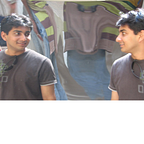Art Of Grins
Ancient Indian visual artistry
There are three forms of visual art: Painting is art to look at, Sculpture is art you can walk around, and architecture is art you can walk through
— Dan Rice
The experience of stepping into an ancient Indian temple can be best described like entering a womb lost in space and time. It’s like a time capsule that takes you back a thousand years. When entering an ancient living temple you are invited with a beautiful display of ancient paintings , sculptures and architecture that offers a glimpse into the past. It leaves me pondering what those who lived centuries ago aimed to communicate to future generations. It’s a treasure trove of puzzles, with each sculpture and painting eagerly awaiting interpretation by inquisitive minds passing by, seeking to unravel their mysteries in a contemporary context. This sharply contrasts with the more vibrant aspect of ongoing rituals, musical events, and religious ceremonies, which abruptly brings you back to the present. While I don’t hold the title of anthropologist, my inquisitive nature propels me to share my observations through this story.
I was fortunate to visit the Brihadisvara Temple, constructed in the year 1010 CE by Rajaraja 1. The temple is part of the UNESCO world heritage site, and now known as the “Great Living Chola Temples” with the other two being the Gangaikonda Cholapuram and Airavatesvara temple.
I had the opportunity to visit the temple on Rajaraja’s birth anniversary. On this occasion, the temple was adorned with festive decorations, featured a variety of musical events, and was bustling with the presence of local visitors, truly living up to its reputation as one of the “Great Living Chola Temples”. One easy way to get to know about Cholas is to watch movies based on a historical fiction — Ponniyin_Selvan
It is one of the largest temples in India and is an example of Dravidian architecture during the Chola period. The temple turned 1000 years old in 2010. The entire temple structure is made out of granite, the nearest sources of which are about 60 km to the west of temple.
The Kumbam (the apex or the bulbous structure on the top) of the temple is carved out of a single rock and estimated to weigh around 80 tons.
Transcending ideas through art across generations
Throughout human history, the desire to evade death has remained a persistent fantasy. I feel art, monuments, sculptures, media and now machines are crafted in this likeness, with the aim of allowing our ideas to transcend multiple lifetimes. Art truly has the power to transcend time and connect with people from different eras, making it a timeless and impactful form of expression.
Overall, the meticulous attention to detail in the sculptures of this temple is truly captivating. I was particularly trying to interpret the emotions conveyed, specifically in the animal sculptures.
One sculpture which caught my eye was that of what I call — “A grinning horse”.
Take a moment to observe the intricacies, such as the reef knot securely fastened to the horse, accompanied by various embellishments. The meticulous details carved into this horse left me utterly mesmerized.
However, what puzzled me was that the teeth were carved to resemble human teeth rather than the distinctive teeth of individual animals.
Curiously, upon searching the internet for “smiling horse cartoon,” I came across numerous images featuring cartoon horses with teeth depicted similarly to the grinning horse. Does the grin aim to make the animals more relatable to humans? In reality, the teeth of horses or bulls bear no resemblance to the depiction found here. Could the unique representation of teeth in ancient sculptures be a deliberate artistic choice to bridge the gap between animal and human characteristics?
The message
The discrepancy in teeth depiction might be a result of artistic license, enabling sculptors to convey emotions or expressions that surpass the anatomical accuracy of real-life animals. Both bovines and equines are recognized for their high level of emotional intelligence. The sculptors seem to intentionally portray the teeth of horses or bulls differently, possibly aiming to establish a connection with human features and achieve relatability. I feel that the importance of these animals in building society back then is immortalized by these sculptures, possibly conveying a message to us.
Throughout history, we’ve cultivated a symbiotic relationship with these animals. The well-being and sustenance of these animals are indispensable for our society. These creatures have played a crucial role in the past, such as in transportation, agriculture and will continue to contribute significantly to future societal aspects, such as sports and therapy.
